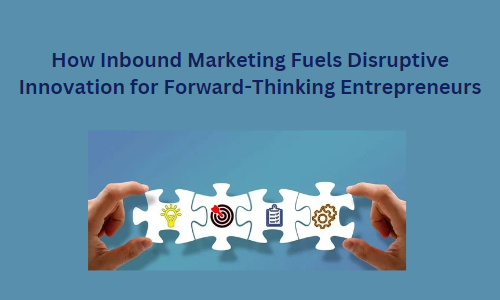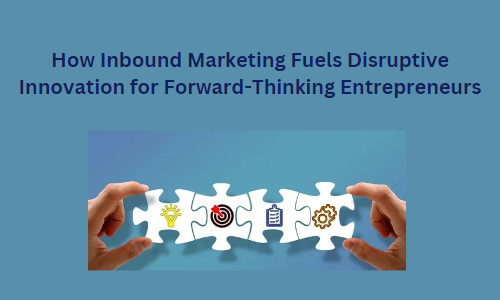


In today’s dynamic business world, the ability to innovate and disrupt traditional markets is crucial for entrepreneurs looking to stay ahead. Inbound marketing—focused on attracting and engaging customers through valuable content and experiences—plays a significant role in driving disruptive innovation. This article explores how inbound marketing can be a powerful catalyst for disruptive change and provides actionable insights for entrepreneurs aiming to lead their industries.
Inbound Marketing: A Modern Approach
Inbound marketing revolves around drawing customers to your brand through relevant and valuable content. Instead of relying on interruptive methods like traditional advertising, inbound marketing builds trust and relationships by offering solutions that align with your audience’s needs. Key components include content creation, SEO, social media engagement, and lead nurturing. By focusing on these elements, businesses can attract, engage, and delight customers in a more organic and effective manner.
Disruptive Innovation: Redefining Markets
Disruptive innovation refers to innovations that create new markets and value networks, often displacing established businesses. Disruptive innovations typically start in niche markets or underserved segments and gradually move upmarket, eventually changing industry norms and practices. Here are a few examples:
1. Netflix: Revolutionizing Entertainment
Netflix began as a DVD rental service in 1998 but disrupted the entertainment industry with its transition to streaming in 2007. By offering on-demand access to a vast library of content without the need for physical rentals, Netflix transformed how people consume media. Its model shifted the industry from physical rentals and purchases to digital streaming, impacting how content is produced, distributed, and consumed.
2. Zoom: Transforming Remote Communication
Zoom Video Communications, founded in 2011, revolutionized remote communication with its easy-to-use video conferencing platform. While video conferencing was not new, Zoom’s superior user experience, reliability, and scalability set it apart from competitors. Its rapid adoption during the pandemic highlighted its role in remote work, virtual meetings, and social interactions, effectively disrupting traditional office environments and communication practices.
1. Identifying Market Needs
Inbound marketing helps identify and understand market needs by providing valuable content and engaging directly with potential customers. Through blog posts, social media, and feedback mechanisms, entrepreneurs can gather insights into customer pain points and desires. This data is crucial for recognizing market gaps and identifying opportunities for disruptive innovation.
2. Validating and Refining Innovative Ideas
Once an innovative idea is identified, inbound marketing can be used to test and refine it. Entrepreneurs can leverage content to present their ideas to their audience and gather feedback. For instance, launching a survey or writing a series of blog posts about a new concept can provide valuable input and help fine-tune the innovation based on real-world responses.
3. Building a Strong Brand Presence
Establishing a strong brand presence through inbound marketing is vital for disruptive innovations. By consistently producing high-quality content and engaging with their audience, entrepreneurs can build thought leadership and credibility. This not only attracts early adopters but also helps in scaling the innovation as it gains traction in the market.
1. HubSpot: Revolutionizing Marketing Automation
HubSpot, founded in 2006, is a prime example of how inbound marketing can drive disruptive innovation. By pioneering the concept of inbound marketing and offering a comprehensive suite of tools for content management, SEO, and lead nurturing, HubSpot transformed the marketing automation industry. Its focus on providing valuable resources and educational content helped it establish itself as a leader in the field and redefine how businesses approach marketing.
2. Airbnb: Transforming the Hospitality Industry
Airbnb, founded in 2008, disrupted the hospitality industry by offering a platform where individuals could rent out their homes or spare rooms to travellers. This peer-to-peer model provided unique and often more affordable lodging options, challenging traditional hotel chains and creating a new way for people to experience travel. Airbnb’s success was fuelled by its effective use of inbound marketing to engage hosts and travellers and build a strong community.
3. Spotify: Redefining Music Consumption
Spotify, launched in 2008, revolutionized the music industry with its streaming model. By offering users access to a vast library of music on demand through a subscription-based service, Spotify shifted the focus from ownership of individual tracks to on-demand access. This model not only disrupted traditional music sales but also influenced how artists and record labels generate revenue and engage with audiences.
4. Square: Revolutionizing Payment Processing
Square, co-founded in 2009 by Jack Dorsey and Jim McKelvey, disrupted the payment processing industry with its innovative point-of-sale (POS) solution. Prior to Square, small businesses faced high fees and complex setups to accept credit card payments. Square’s mobile card reader and app allowed businesses to process payments with ease, democratizing payment processing and enabling small enterprises to compete with larger players.
5. Markethive: Innovating in Decentralized Marketing
Markethive is a notable example of how inbound marketing can drive disruptive innovation in the blockchain space. Launched as a decentralized platform, Markethive integrates social media, inbound marketing, and blockchain technology to create an ecosystem for entrepreneurs. It allows users to promote their businesses within a decentralized network, offering features such as a comprehensive inbound marketing toolkit, a social media platform, and a unique cryptocurrency-based Hivecoin (HVC) reward system. By leveraging blockchain technology, Markethive disrupts traditional social media and marketing platforms, providing entrepreneurs with a secure and innovative way to engage with their audience and grow their businesses.
1. Develop a Comprehensive Inbound Marketing Plan
To effectively leverage inbound marketing, entrepreneurs should develop a well-rounded plan that includes:
2. Innovate with Content
Keep your content fresh and engaging by experimenting with different formats such as podcasts, webinars, and interactive content. Storytelling can also be a powerful tool to convey your innovative ideas and connect with your audience on a deeper level.
3. Measure and Refine
Regularly track and analyse the performance of your inbound marketing efforts. Use metrics and KPIs to understand what works and what needs improvement. Refine your strategies based on these insights to ensure they align with your innovation goals.
Inbound marketing and disruptive innovation are intrinsically linked. By harnessing the power of inbound marketing, entrepreneurs can effectively identify market needs, validate innovative ideas, and build strong brand presences that drive disruptive change. As you pursue your entrepreneurial journey, remember that a well-executed inbound marketing strategy can be a powerful force, propelling your innovative ideas into the spotlight and setting new standards in your industry.
Disclaimer: This article is provided for informational purposes only. It is not offered or intended to be used as legal, tax, investment, financial, or other advice.
